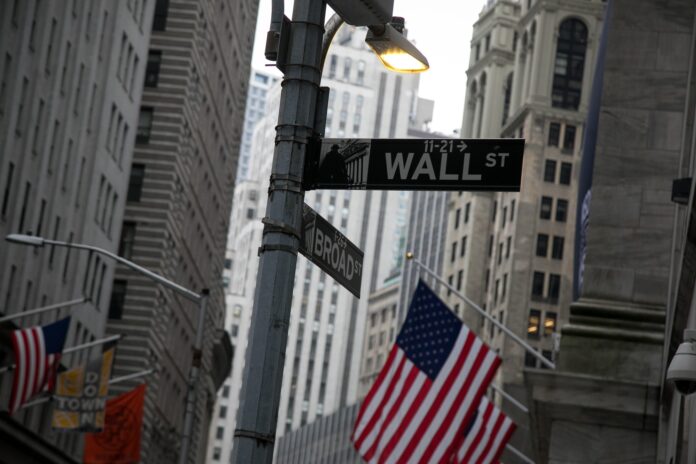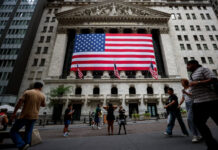
Bonds rose after the latest batch of economic reports reinforced speculation the Federal Reserve will be able to cut interest rates this year to prevent a bigger US slowdown.
Treasuries climbed across the curve as data showed recurring applications for jobless benefits hit the highest level since the end of 2021 while orders placed with factories for business equipment unexpectedly declined. An index of US pending existing-home sales unexpectedly fell to the lowest level on record as elevated mortgage rates and high prices discouraged prospective buyers.
To Chris Low at FHN Financial, the slowdown story got stronger.
“Continuing claims inched higher and are now the highest since late 2021 — sending a warning sign that the labor market could be softening,” said Jeff Roach at LPL Financial. “We expect both consumer and business activity to slow in the latter half of 2024, giving the Fed ample opportunity to begin cutting rates later this year.”
Treasury 10-year yields declined five basis points to 4.28%. That’s ahead of a $44 billion sale of seven-year notes later Thursday and Friday’s release of the Fed’s preferred inflation gauge. Fed Bank of Atlanta President Raphael Bostic said he continues to expect one rate cut this year amid signs inflation has resumed its decline.
The S&P 500 edged up. Most megacaps rose — though Nvidia Corp. joined losses in fellow chipmaker Micron Technology Inc., whose forecast disappointed investors. Walgreens Boots Alliance Inc. tumbled over 20% after slashing its guidance due to a worsening retail environment.
Traders in the swaps market are pricing in about 45 basis points of easing in 2024, which would equate to less than two cuts. US central bankers left their benchmark rate unchanged at a more than two-decade high earlier this month. Policymakers say they need to see more data to be convinced that inflation is on a sustainable path toward their 2% target.
Friday’s personal consumption expenditures price data is expected to be the slowest yet this year — welcome news for Fed officials, according to Stuart Paul at Bloomberg Economics.
“But with bottoms-up analysis pointing to disinflation stalling in months ahead, it will take swifter cooling in the labor market for the Fed to start cutting rates,” Paul noted. “With consumers showing more restraint amid rising unemployment, we think the door is still open for two rate cuts this year.”
Worries about the strength of the labor market and the subsequent effect on consumer spending — in addition to the market’s reliance on just a handful of stocks — have caused consternation and warnings that the bull market needs a rest, recalibration and maybe help from the Fed, according to Quincy Krosby at LPL Financial.
Should Friday’s PCE data disappoint, stagflation headlines will hit the tape, she noted. But if estimates hold or surprise with cooler data, it should help the market ease into July.
“Still, an overbought market and relatively expensive market based on just a handful of mega names may need to recalibrate and allow other sectors to co-exist with them or even begin to lead the market,” Krosby said. “Such adjustments can trigger pockets of volatility coupled with attractive pockets of opportunity.”
In a month when Nvidia Corp. briefly became the world’s largest company, hedge funds were “aggressively” selling tech stocks, according to analysis from Goldman Sachs Group Inc.
This month’s net selling in the US tech sector is on track to be the largest on record going back in data since 2017, according to Goldman’s prime brokerage data. The trimming of exposure by hedge funds is in sharp contrast to the record inflows seen into tech-related funds last week.
Investors got a taste of what a reckoning for Nvidia shares might look like when the chipmaker, seemingly out of the blue, plunged 13% over the span of just three days, erasing $430 billion in market value. The shares snapped back on Tuesday and after edging higher again on Wednesday, have recouped about half their losses from the selloff. Nvidia shares fell Thursday after results from fellow chipmaker Micron Technology Inc.
To Chris Senyek at Wolfe Research, volatility will likely continue to pick up, and this will generally benefit the “Magnificent Seven” megacaps and the overall momentum trade in the weeks ahead.
“More specifically, we expect these themes to continue to benefit from environment in which growth is slowing but the Fed is expected to kick off a deep cutting cycle,” he noted. “Further, our sense is that the biggest companies driving these trends will once again put up very solid results during the second-quarter earnings season.”
The higher technology stocks go, the less tolerant one nook of Wall Street gets to any signs of weakness in the group.
Commodity trading advisors, or CTAs, that use trend-following strategies boosted exposure in Nasdaq 100 futures to such stretched levels that the so-called stop-loss triggers have become very tight, according to Bank of America Corp.
From where things stand, CTAs can start unwinding their positions if the gauge’s futures drop 2.8% or more. A month ago, the pain threshold hovered near 4%.
Corporate Highlights:
- Boeing Co. said it’s seeing a sharp drop in defects on 737 Max fuselages arriving from supplier Spirit AeroSystems Holdings Inc. and an uptick in the pace at which the cashcow planes move through its factory south of Seattle.
- Denim maker Levi Strauss & Co. reported quarterly sales that fell just short of estimates, underscoring Wall Street’s high expectations for the company.
- International Paper Co. plunged after Suzano SA said it would end its pursuit of the US paper giant.
- Customers of major US telecommunications companies including AT&T Inc., T Mobile US Inc. and Verizon Communications Inc. are reporting issues connecting to their networks while roaming outside of their home countries.
- Novo Nordisk A/S will restrict initial sales of its blockbuster obesity treatment Wegovy in China, as the drugmaker grapples with how to control access to the medicine for the world’s biggest population of obese people.
Key events this week:
- Japan Tokyo CPI, unemployment, industrial production, Friday
- US PCE inflation, spending and income, University of Michigan consumer sentiment, Friday
- Fed’s Thomas Barkin speaks, Friday
Some of the main moves in markets:
Stocks
- The S&P 500 rose 0.1% as of 10:23 a.m. New York time
- The Nasdaq 100 rose 0.3%
- The Dow Jones Industrial Average rose 0.1%
- The Stoxx Europe 600 was little changed
- The MSCI World Index rose 0.1%
Currencies
- The Bloomberg Dollar Spot Index fell 0.2%
- The euro rose 0.3% to $1.0714
- The British pound rose 0.2% to $1.2653
- The Japanese yen rose 0.1% to 160.58 per dollar
Cryptocurrencies
- Bitcoin rose 2.1% to $62,258.37
- Ether rose 2.4% to $3,470.7
Bonds
- The yield on 10-year Treasuries declined five basis points to 4.28%
- Germany’s 10-year yield declined one basis point to 2.44%
- Britain’s 10-year yield declined two basis points to 4.11%
Commodities
- West Texas Intermediate crude rose 0.9% to $81.63 a barrel
- Spot gold rose 1.1% to $2,323.96 an ounce

















